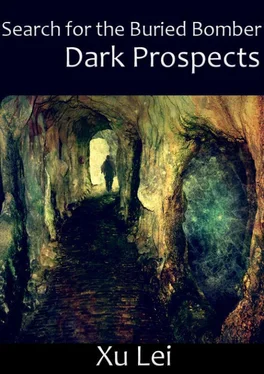We did a brief search, though not the slightest hint remained of the soldier’s presence. “Something’s not right here,” said the deputy squad leader. “Our adversary is probably not alone. He must have taken off when he saw our lights, but he might be back in a moment with an accomplice. It’s not safe for us to wait here. We’d better get going as soon as we can.”
There was no longer any reason for me to return to the chamber, saving us a lot of time. I took a moment to orient myself, then Ma Zaihai put me on his back and we set off toward the iron door. Our journey was very smooth. By the time we reached the factory, I could already see the distant light of Wang Sichuan’s fire. As soon as the word fire crossed my mind, a piercing pain shot through my body. The faster I could warm up, the better. The deputy squad leader and Ma Zaihai were unbearably cold themselves. They ran the whole way, Ma Zaihai shouting, “Engineer Wang! Engineer Wang!”
Then someone moved from beside the campfire. A moment later, ten people emerged from behind a canvas sheet. They were all dressed in Japanese military uniforms.

CHAPTER 43

Japanese Soldiers
The three of us froze. Up till then I’d been in a state of slight disbelief. Could the Japanese uniform I glimpsed have been no more than an illusion? How sure could I be about what I saw while I was being kicked from a ledge? Never would I have expected that, before long, I would actually see this many Japanese soldiers. It was like we’d passed through a tunnel in time: seeing those vile yellow uniforms made me feel as if we’d been transported back to the War of Resistance. But something wasn’t right. Why did all these soldiers look so familiar? I looked again, and then I saw it. The Japanese officer raising his head was Old Cat!
As I stood there in shock, Pei Qing and Wang Sichuan walked over to greet us. Wang Sichuan circled around me, looking at the broken bits of ice coating my clothing. “What happened to him?” he asked the deputy squad leader. I was picked up and set down by the fire, my clothes removed. The fire was really something—huge and warm—and I began to tear up, though I had no idea why.
We were still clothed in rags, but Old Cat and the rest were all wearing neat and tidy Japanese military garb. The best was Old Cat in his dark-colored officer’s uniform. With his inscrutable expression, it made him look just like a Japanese staff officer from the movies. After being wrapped in a sleeping bag, I found myself sitting directly across from him. At last both of us laughed. And with that, everyone around us began to laugh as well.
“What the hell is going on?” I asked them. “What are you helping those bastards for? At what point did you defect and become Japanese devils?”
“Don’t wrong the innocent,” said Pei Qing. “We’re undercover behind enemy lines.” We all cracked up again.
Pei Qing said the route they took was just too damn cold, though he still didn’t know why. They’d discovered these uniforms in a storage area. At first no one dared wear them, but after the cold became unbearable, they all put them on. It was a complete set, meant for one of the Japanese brigades stationed in northeastern China. They too had laughed as they looked at one another.
Remembering the point where we’d split up, I asked how they’d gotten here. Had they ever located the source of the telegram? Several of their faces fell. Pei Qing sighed, nodded his head, and said they’d found it, but the people were already dead. He gestured wearily as he said this, then gave a basic retelling of what had happened.
Here I must once more put my memories in order. Pei Qing and the others gave us no more than a sketchy narration of their experiences. With all the years that have passed since then, I seem to have already forgotten many of the particulars. Or perhaps it was Pei Qing’s story that wasn’t especially detailed. In any case, those parts aren’t important.
Following the power cable, they’d floated down the waterway. They called it “River 6,” the name given to it by the Japanese. It turned out to be a tributary of “River 0,” the main river, the one that flows into the dam. They’d drifted deeper and deeper into the cave. It was just as Old Tang had surmised: the power cables and underwater rails signified that the region had been a densely builtup, high-activity area. The terrain became smoother and flatter the farther they advanced. Not a single obstacle presented itself, and the signs of Japanese activity became increasingly numerous and varied. After they’d been drifting for about forty minutes, the river bottom began to trend upward. The water level became shallower and shallower. Before long a number of shoals appeared. The shoals increased in number, until at last they ran together as a continuous expanse. At first there was still some water atop the shoal and they’d had to wade, but soon the river came to a stop, replaced by a great rocky beach. At this beach River 6 began to branch off into smaller tributaries running back into the cavernous depths.
They marched up the rock beach. They could see a huge cavern up ahead. It was quite flat, though thrown into complete disorder. Stacks of supplies protected by water-resistant canvas sheets covered the cave floor. They lifted off the covers. There were loads of writing desks and correspondence equipment. All manner of power cables hung from the stalactites. Cables thick and thin snaked across the ground, the ceiling, and every place in between. There were also temporary beds and wooden trunks filled with supplies. It was from these that they’d taken their Japanese military uniforms.
At the end of the limestone cave were a number of branching paths, some piled with supplies, some so deep you couldn’t see the end. A mass of power cables ran down them. Old Tang surmised that the end of River 6 was the communications center for the entire underground river. That meant it was also the wiring center for the telephone system. The power for this place was provided by the small-scale generator we’d come across in the sinkhole. From what Pei Qing and the others could see, the Japanese had neglected to burn their files, simply covering them up with canvas sheets instead. They must have been expecting to return. This ran contrary to all our experiences with abandoned Japanese installations. Once more I found myself at a loss as to what exactly had happened when the Japanese left. Just what had they been ordered to do?
After taking a rushed look around, Pei Qing and the others continued to follow the power cables, searching for the source of the telegram. Old Cat thought the survivors from the earlier exploration team would have waited here to be rescued. He whistled to alert them of our presence. This lonely whistle received not a single sound in response. In the end it was Old Tang and the former communications soldier who, after examining the countless electrical connections, located the telephone wire. It extended into a passage in the far recesses of the cavern. Old Tang led the way. About sixty feet into the tunnel, they began to smell an odor of decay. Then they saw the telegraph room. The automatic transmitter was inside. Next to it a canvas sheet covered something. Pei Qing lifted it off. Three corpses were underneath.
There were two men, one of them old, and a woman. All three were draped with khaki-yellow Japanese overcoats. Underneath, they wore PLA uniforms no different than ours. They had already begun to rot. Pei Qing didn’t recognize them, but they had to be the survivors Old Cat was looking for. Well, not survivors, really. They’d been dead for some time.
Читать дальше














